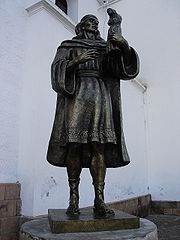| Virgen de Copacabana | |
|---|---|
| Woodcarving of the coronation of the Virgen de Copacabana. | |
| Venerated in | Roman Catholic Church |
| Major shrine | Church of Copacabana |
| Feast | February 2; August 5 |
| Patronage | Bolivia |
The Virgen de Copacabana (literal translation: Virgin of Copacabana; figurative translation: Our Lady of Copacabana; variant: Blessed Virgin of the Candelaria, Our Lady of Copacabana) is the patron saint of Bolivia. She is venerated in Bolivia during her feast day of February 2, the day of the Purification of Mary, or feast of the Virgen de la Candelaria. She is also venerated on August 5 with her own liturgy and popular celebration.
History[]
Copacabana is a Bolivian town located on a peninsula at the southeastern shore of Lake Titicaca. It is close to Isla del Sol and Isla de la Luna, islands sacred to the Aymara and Inca. In the mid 16th century, the inhabitants of Copacabana were divided into two groups: Anansayas, Inca newcomers, and Urinsayas, the traditional residents of the region. Despite conversion to Christianity, they continued an attachment to their original religion. Poor harvests lead them to consider attracting favor from heaven through a new confraternity. The Anansayas resolved to venerate the Virgin Mary while the Urinsayas selected San Sebastian.[1]

Statue of the sculptor Francisco Tito Yupanqui.
Francisco Tito Yupanqui, an amateur sculptor, a descendant of the Inca Huayna Capac, and a member of the Anansayas, did not abandon the idea. He decided to create an image of the Madonna, believing it would influence the local people. Using clay, and assisted by his brother Philip, Francisco Tito created the image of the Virgin. The sculpture was placed at the side of the altar by the pastor, Father Antonio de Almedio. After Father Antonio left Copacabana, the priest Don Antonio Montoro took over. Unhappy with the look of the coarse and disproportionate sculpture, he ordered that it be removed from the altar and be placed in a corner of the sacristy.
Francisco Tito was humbled by this setback. Advised by relatives, he went to Potosi which had outstanding teachers of sacred image sculpting. While studying in the workshop of Maestro Diego Ortiz, Francisco Tito gained expertise in sculpture and in wood carving. With this skill, he resolved to create an improved image of the Candelaria. He looked through the churches of Potosí for an image of the Virgin which could serve as a model, finally finding the best one in the Convent of Santo Domingo to the Virgen del Rosario. He studied it closely to remember it before starting his new piece and held a Mass in honor of the Holy Trinity as a divine blessing for his work.
The Urinsayas accepted the establishment of the Virgin Mary confraternity, but they the did not accept Francisco Tito's carving, and decided to sell it. In La Paz, the picture reached the priest of Copacabana who decided he would bring the image to the people. On 2 February 1583, the image of Mary was brought to the hills of Guaçu. A series of miracles[1] attributed to the icon made it one of the oldest Marian shrines in the Americas, along with Guadaloupe in Mexico and Cocharcas in Peru.
Construction of the basilica[]
From its beginning, the image gained a reputation for being a miracle. The Augustinians built their first chapel between the 1614 and 1618, and later, the Viceroy of Lima, Conde de Lemos, morally and financially supported the construction of a basilica to honor the Virgin. Construction of the Basilica of Our Lady of Copacabana began in 1668, was inaugurated in 1678, and was completed by 1805. The venerated image was blessed during the Papal visit of Pius XI. Subsequently, the faithful donated embellishments to the image, including valuable jewels, and the temple was filled with gifts and treasures.
In 1825, when Bolivia gained independence, it was attributed to the faith of the population through the Virgin of Copacabana. However, in 1826, Marshal Antonio José de Sucre, the President of the Republic of Bolivia, expropriated all the jewels and colonial treasures at the Shrine of the Virgin, using them to create the first coins from Bolivia.
Carving description[]
The body of the image is carved in maguey wood and is gold laminated. The clothes are that of an Inca princess. The form is covered with luxurious robes and dresses, and wears a wig of long, natural hair. The image measures a little over four feet. It holds a child in a peculiar position, as if about to fall. In her right hand, she holds a basket, and a baton, a gift and souvenir of the visit in 1669 from the viceroy of Peru. The original image never leaves the sanctuary; a copy is used for processions. Those leaving the shrine walk backwards with the intention not to turn your back on the Virgin.
Devotion in other countries[]
The Bolivian community in Argentina celebrates the Feast of the Virgin of Copacabana in Buenos Aires in October.
References[]
- ↑ 1.0 1.1 McCarl, Clayton. "An Indigenous Sculptor on the Spanish Stage: Calderón’s rewriting of Tito Yupanqui in La Aurora en Copacabana". cuny.edu. http://ojs.gc.cuny.edu/index.php/lljournal/rt/printerFriendly/257/221. Retrieved 2009-08-11.
External links[]
- Our Lady of Copacabana, Bolivia (Spanish)
- Virgin of Copacabana, Patron Saint (Spanish)
- Virgin of Copacabana (Spanish)
- Copacabana: A Virgin venerated in Brazil (Spanish)
qu:Qupaqhawanap Pallan

